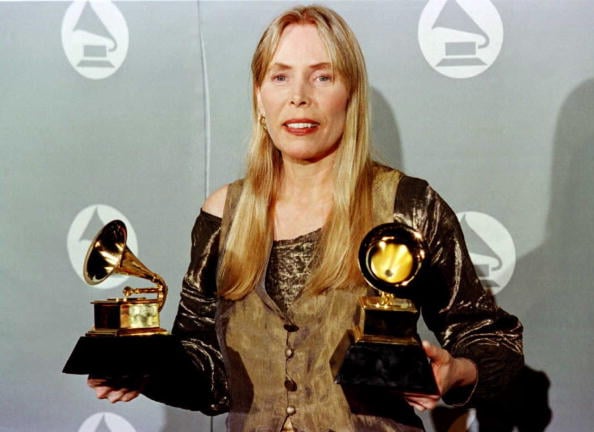What Is Joni Mitchell's Net Worth?
Joni Mitchell is a Canadian-American singer, songwriter, musician, and painter who has a net worth of $150 million. Emerging from the 1960s folk scene, she became one of the most influential and poetic voices in contemporary songwriting. Known for her deeply personal lyrics, complex harmonies, and innovative open-tuned guitar style, Mitchell's music evolved far beyond folk to encompass pop, rock, and jazz influences. Her artistry is marked by both lyrical introspection and a painter's sense of tone and texture, making her one of the most acclaimed musicians of the 20th century.
Her early albums, including "Song to a Seagull" (1968), "Clouds" (1969), and "Ladies of the Canyon" (1970), established her reputation as a singular songwriter, with tracks like "Both Sides Now" and "Big Yellow Taxi" becoming enduring classics. In 1971, she released "Blue," often cited as one of the greatest albums ever recorded, praised for its emotional rawness and lyrical vulnerability. Mitchell continued to push boundaries with "Court and Spark" (1974), her most commercially successful album, which blended pop accessibility with jazz sophistication. Later works, such as "The Hissing of Summer Lawns" and "Hejira" reflected her growing experimentalism and collaboration with jazz legends like Jaco Pastorius and Wayne Shorter.
Though her mainstream popularity declined in later decades, Mitchell's influence deepened across generations of artists, from Prince and Madonna to Taylor Swift and Brandi Carlile. After a 2015 brain aneurysm left her temporarily unable to speak or walk, she made a remarkable recovery, returning to the stage in 2022 and 2023 to widespread acclaim. Beyond music, Mitchell is an accomplished painter whose visual art often graces her album covers. Her legacy endures as one of fearless creativity, poetic insight, and profound emotional honesty. In 2002, she was appointed a Companion of the Order of Canada (CC), which is Canada's highest civilian honor.
Song Catalog
Thanks to shrewd negotiating skills and her insistence on creative control from the very beginning, Joni Mitchell owns 100% of her master recordings and publishing royalties—a rarity for artists who came up in the 1960s. Mitchell was notoriously protective of her work, often clashing with record executives who wanted more radio-friendly songs. She produced every one of her albums herself, giving her not only artistic freedom but also full ownership of the final product. This independence has paid off handsomely over time, as her songs have become standards covered by hundreds of artists across genres.
"Big Yellow Taxi" alone has generated significant income through countless cover versions, including hit renditions by Counting Crows with Vanessa Carlton in 2002, Amy Grant in 1995, and even a charting dance remix in the early 2000s. Each time one of those covers is streamed, sold, or licensed in a film or commercial, Joni receives the bulk of the royalties. Her catalog also includes enduring songs like "Both Sides Now," "River," and "A Case of You," which have been recorded by everyone from Frank Sinatra and Judy Collins to Prince and James Blake. In interviews, Mitchell has expressed a mix of pride and amusement about this long-tail success, once joking that "Big Yellow Taxi" turned out to be "my environmental protest song that paid the rent."
Her ownership structure also means she's been able to control how her music is licensed. Mitchell famously pulled her entire catalog from Spotify in 2022 in protest over misinformation on the platform, illustrating how her independence has allowed her to make principled, rather than purely financial, decisions about her legacy.
Early Life
Joni Mitchell was born Roberta Joan Anderson on November 7, 1943, in Fort Macleod, Alberta, Canada. Her mother was of Scottish and Irish ancestry, and she worked as a schoolteacher. Her father's family was Norwegian, and he was a Royal Canadian Air Force lieutenant who worked as a flight instructor at RCAF Station Fort Macleod while Joni was a young child. After World War II ended, he started working as a grocer, and the family moved around the sparsely populated Saskatchewan province for several years. At age nine, Mitchell contracted the polio virus and spent several weeks in the hospital, and she began smoking cigarettes at that age. When she was 11, her family settled in the town of Saskatoon. As a child, Mitchell displayed an interest in playing music, singing, and painting. During her bout with polio, she would perform for other patients in the hospital. She struggled in school but was engaged in her poetry and writing classes. She attended high school at Aden Bowman Collegiate, and after graduating, she enrolled at the Saskatoon Technical Collegiate Institute to study art and painting.

(Photo by Michael Putland/Getty Images)
Early Career and Breakthrough
While attending college, Mitchell worked as a singer and performer for The Depression Coffee House, and she sang on local television in addition to radio stations. When she was 20 years old, she decided to pursue folk singing as a career in Ontario, and she left western Canada for the first time in her life. Once in Ontario, she took jobs performing folk music for small gatherings, clubs, and other less formal venues. In 1964, Joni became pregnant, and her boyfriend left her. Having no means to support a child, she gave the baby girl up for adoption in 1965.
Folk singer Tom Rush had met Mitchell and been given one of her songs, "Urge for Going," and in the late 1960s, he recorded himself playing it. Other artists heard him performing it, and the song began to catch on in folk circles. In the spring of 1968, Joni signed with the record label Reprise and released her debut album, "Song to a Seagull." It landed at #189 on the "Billboard" 200 chart and was praised by critics. She released her next album, "Clouds," in 1969, and she won a Grammy for Best Folk Performance the following year. The album performed better than her debut, landing at #31 on the "Billboard" 200 chart, and her third album, 1970's "Ladies of the Canyon," peaked at #27 and was later certified Platinum. Her next album, "Blue," was a commercial success, and it frequently appears on lists of greatest albums of all time. Following the album's release, Mitchell went on tour, then she produced two more critically acclaimed albums, "For the Roses" and "Court and Spark." For the latter, she received four Grammy nominations, with one win, in 1975. During this period, her musical style had shifted away from pure folk and moved towards more experimental, jazz-inspired sounds. Joni finished the '70s with the albums "The Hissing of Summer Lawns," "Hejira," and "Don Juan's Reckless Daughter," and she collaborated with jazz artist Charles Mingus for his 1979 album "Mingus." While her albums in the '70s were commercially and critically successful, her stylistic shift towards jazz confused her fans, and the albums weren't as big of hits as her previous ones.

JEFF HAYNES/AFP/Getty Images
Eighties and Nineties
Joni Mitchell returned to her folk and pop roots with her 1982 album "Wild Things Run Fast," which peaked at #25 on the "Billboard" 200 chart, but her 1985 album "Dog Eat Dog" only performed moderately well. She reached larger audiences with her 1994 album "Turbulent Indigo," which won her two Grammys. The album introduced Mitchell to a younger generation of artists. After agreeing to release a greatest hits album, "Hits," her record label allowed her to release an album of her lesser-known songs called "Misses." In the U.S., "Hits" charted at #161, but it performed much better in the U.K., peaking at #6 on the charts. In 1998, Joni released "Taming the Tiger," which would be her last release of new and original songs until 2007's "Shine." She released "Both Sides Now" in 2000 and "Travelogue" in 2003 to fulfill contractual obligations. Both albums featured reworkings of her older songs.
Personal Life
Joni was married to fellow folk musician Chuck Mitchell from 1965 to 1967. In 1987, she married bassist and sound engineer Larry Klein. They divorced 12 years later. Joni signed a deal with Random House in 1990 to publish her autobiography, and although she previously stated that it would be at least four volumes, she revealed in 2015 that she was recording them orally instead.
She was inducted into the Canadian Music Hall of Fame in 1981, and in 2000, she received a star on Canada's Walk of Fame. She received a Grammy Lifetime Achievement Award in 2002. In 2015, Mitchell suffered a brain aneurysm rupture, which required extensive physical therapy and daily treatments. She has also stated that she has Morgellons syndrome, which is a little-understood condition that causes sores to appear on the skin. Due to her medical issues, Joni has made fewer public appearances and has focused on her archival releases, which include records from her personal vault. In 2020, she received the Les Paul Award and was the first woman to have been given the honor.
Real Estate
For many years, Joni's primary residence has been a large house in Bel Air, California. If this house hit the market, it would likely be worth $15 – $20 million.
/2021/01/joni-mitchell.jpg)
/2012/12/Jose-Feliciano.jpg)
/2010/11/Damien-Rice.jpg)
/2024/03/Brandi-Carlile.jpg)
/2009/11/Michael-Stipe.jpg)
/2022/06/Graham-Nash.jpg)
/2020/01/lopez3.jpg)
/2019/04/rr.jpg)
/2020/02/Angelina-Jolie.png)
/2018/03/GettyImages-821622848.jpg)
/2019/11/GettyImages-1094653148.jpg)
/2020/06/taylor.png)
/2009/09/Cristiano-Ronaldo.jpg)
/2009/11/George-Clooney.jpg)
/2020/04/Megan-Fox.jpg)
:strip_exif()/2015/09/GettyImages-476575299.jpg)
/2019/10/denzel-washington-1.jpg)
/2021/01/joni-mitchell.jpg)
/2022/06/Graham-Nash.jpg)
/2013/01/judy-collins-1.jpg)
/2012/11/gordon-lightfoot-1.jpg)
/2023/02/amy-grant.jpg)
/2012/12/Jose-Feliciano.jpg)
/2009/11/Michael-Stipe.jpg)
/2021/01/Tracy-Chapman.jpg)
/2017/02/GettyImages-528215436.jpg)
/2009/09/Brad-Pitt.jpg)
:strip_exif()/2009/09/P-Diddy.jpg)